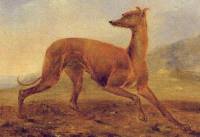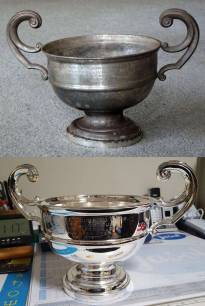From Coursing to Greyhound Racing
 Kangaroo Dog 1853
Kangaroo Dog 1853
The sport of Greyhound Racing began by coursing Kangaroo Dogs. Today, it is an enjoyable spectacle which is strictly governed so that animal welfare is always at its heart. An estimated 300,000 greyhounds take part in some 40,000 races held annually across Australia. Additionally, today Greyhound Adoption Programmes find homes for greyhounds that have retired from or otherwise unsuitable for the racetrack. Re-homed Greyhounds are very popular because they are intelligent and gentle, making them fantastic family pets.
The Sport of Coursing
 Greyhounds with Slipper
Greyhounds with Slipper
The Sport of Coursing had its beginnings 1850's and 1860's when two Kangaroo dogs were coursed against one another using a wallaby as the lure[3]. In 1859, European rabbits were introduced into the Australian wild so that they could be hunted. Thomas Austin, a wealthy settler who lived in Geelong, Victoria had 13 European wild rabbits sent to him from across the world, which he let roam free on his estate. From this one backyard sanctuary, sadly it took only 50 years for this invasive foreign species to spread across the entire continent[4].
The first Meeting to formalise this sport was held in Naracoorte in South Australia in 1868[1a]. In 1873 hare to be used as lures were also imported into Barwon Park in Geelong, Victoria by the same Mr. Austin who introduced rabbits[3a].
The hunter would be mounted on a horse and the hunt would take place in open country. As this attracted more and more spectators, the sport of Coursing evolved. Then Greyhounds were released into an enclosed area rather than riding around in open fields.
 Greyhounds being slipped
Greyhounds being slipped
Coursing consisted of two dogs at a time competing in a series of heats. The dogs wore special collars called 'Slips', allowing allowed them to be released at a moment's notice. So the man who released the dogs was called a 'Slipper'. He would run around behind the Greyhounds and release them at the appropriate moment. The winner was the first dog of the pair to catch the prey. Competitions with several dogs consisted of a series of heats in an elimination process consistent with whatever Rules were in place at that time.
From Coursing to Greyhound Racing
 Early Greyhound Racing
Early Greyhound Racing
As the number of spectators further increased, the area in which the dogs were released became an enclosed circular course. This allowed several Greyhounds to race at the same time. So we have the spectator Sport of Greyhound Racing we know today with its purpose built tracks and appropriate facilities for both the dogs and the spectators.
 Two Greyhounds Coursing
Two Greyhounds Coursing
But as the Australian conditions were so much harsher than the green English countryside, many famous English racing Greyhounds that were imported here to race, suffered[1b]. So mainly with the stronger Australian bred Greyhounds descended from Kangaroo Dogs, the sport prospered. Coursing or Racing Clubs were set up across the country. By the late 1800's, racing Greyhounds was ranked Australia's third fastest growing sport behind horse racing and cricket[1c].
Scotsman Henry Belfrage Nimmo was one of the Greyhound Coursing enthusiasts who arrived in the Western District of Victoria around 1862[6]. He brought his passion with him and became a founding member of the Camperdown Coursing Club. The tasty meals Coursing also provided is obvious by the following which he wrote late in his life, 'Old Bell' being his favourite Greyhound:
 Henry Nimmo with 'Old Bell'
Henry Nimmo with 'Old Bell'
Though eighty-two, and time is fleeting,
I fain* to see another meeting (* means 'eager' or 'willing')
Of coursers true
In friendly rivalry competing
For ribbons blue.
You wonder how that sleek, plump hare
In conflict with 'Old Bell' would fare?
... Next day there'd be hare soup to spare...
 1928 Greyhound Coursing Cup
1928 Greyhound Coursing Cup
Greyhound Racing
Once the mechanical lure was introduced in 1927, most major centres across Australia had Clubs and Greyhound Racing Tracks as evidenced by the solid silver Rose Bowl pictured which was competed for one of these Tracks, at Werribee, Victoria in 1928. Awarded to Victoria's first Greyhound Race winners, it represents part of the transition of Sport of Coursing into today's modern Greyhound Racing industry.
This bowl in its neglected state (top photo) came into my hands after a chance conversation with a neighbour who was moving house and had been using it as a pot plant holder! With some idea of what it represented, I contacted Neil Brown from AGRA (Australian Greyhound Racing Association). The Cup was collected and meticulously restored (lower photo) and is on display at the Werribee Mansion where it belongs.
Greyhound Racing Today
Today, there are a total of 65 Greyhound racing tracks operating across Australia. Greyhound Racing is also a regular betting activity with an estimated $4 billion gambled annually on Greyhound Racing. On the other hand, Greyhounds that love to run are a sight to behold! One can only admire these amazing Sight hounds representing the epitome of dog athleticism.
References and Further Reading
Published in Dog News Australia (Top Dog Media Pty Ltd Austral NSW) Issue 8, 2015 Page 10, also
[1] Anne Rolins, "All About the Greyhound" Published 1982 by Rigby Publishers, Adelaide ISBN 0 7270 1757 8. Chapter 2 'The History of Coursing' Page 19
[1a,b] ibid. Chapter 2 'The History of Coursing' Page 19
[1c] ibid. Chapter 2 'The History of Coursing' Page 21
[3,3a] M.G.Agostini, "The Greyhound in Australia" Published 1969 by F.W.Cheshire Publishing Pty Ltd, Sydney National Library of Australia Registry Number AUS 69-2771 Chapter 1 History Pages 3-4
[4] https://education.nationalgeographic.org/resource/how-european-rabbits-took-over-australia
[6] https://westerndistrictfamilies.com/2017/01/30/passing-of-the-pioneers-51/